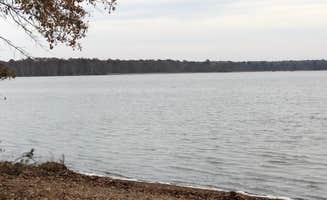Dispersed camping opportunities near Newport News, Virginia include several Wildlife Management Areas (WMAs) within 30-45 minutes of the city. These rustic sites require visitors to obtain the proper permits before camping, with different fee structures for Virginia residents versus out-of-state visitors. The primitive nature of these sites means campers must be self-sufficient, bringing all necessary supplies including water, food, and waste disposal solutions. Seasonal considerations impact site accessibility, with spring and fall offering the most comfortable conditions for primitive camping in this tidewater region.
What to do
Fishing opportunities: Car camping at Eagle Nest Lookout provides direct water access for anglers. "Car camped here 5 feet from the water. There is a large shoreline area to Car camp and right up the hill is a nice tent site as well overlooking the river. Used by fisherman shore fishing," reports one visitor who observed other campers catching substantial fish, including "a 17 pounder and a 25 pounder using a drone to take their lure easy out."
Wildlife viewing: The extensive acreage of these management areas supports diverse wildlife observation opportunities throughout the year. At Chickahominy Wildlife Management Area Site, multiple cleared areas provide spots to set up camp while watching for local species. One camper noted their site had "about 15 cleared areas any one of which I would have been happy with" including "a raised area—about 20' above the drivable area—that would be perfect for a campfire and a tent or two."
Hiking and exploration: Several informal trails wind through the management areas, allowing for day hikes from your campsite. A visitor to Ware Creek Wildlife Management Area mentioned they "Got here late as the sun was going down. Camped in the RAV4. Will explore the area in the morning," highlighting the exploration opportunities available even with vehicle-based camping.
What campers like
Waterfront positioning: The proximity to water ranks highly among camper preferences. At Chickahominy WMA, one camper reported, "I arrived with a small (18') trailer and put it within 5' of the water." This waterfront access provides both scenic value and practical benefits for activities like fishing and wildlife observation.
Privacy between sites: The distributed nature of these camping areas means substantial distance between campers. One visitor described Ware Creek Wildlife Management Area as a "Basic parking spot in quite location" with weekend activity primarily limited to "some hunters and shooting range close by in other side." The same camper noted "It's 2 parking side by water and some other ones on the way while driving."
Cost-effective camping: The permit structure makes these sites affordable options for overnight stays. A camper explained the fee system: "Camping here is free but there is a $4 daily use fee to be in the WMA that you can pay via phone, website or app" and noted that Virginia residents with proper licenses receive "free 14 days camping complementary as well with any fishing license or hunting license."
What you should know
Trash management challenges: Several reviewers mention issues with previous campers leaving trash behind. One visitor to Eagle Nest Lookout reported, "There was quite a bit of trash dispersed in this area in which we picked up." Another camper observed "unfortunately Trash was present but we walked around and picked up."
Hunting activity impacts: As these are Wildlife Management Areas, hunting seasons affect camping experiences. During peak hunting seasons (particularly fall and winter weekends), campers should expect increased vehicle traffic and potential noise. One visitor noted: "Weekends some hunters and shooting range close by in other side."
Limited amenities require preparation: All sites lack basic facilities like water, restrooms, or trash service. A camper at Eagle Nest Lookout summarized the conditions as "No water, no toilet, Pack it in, Pack it out. LNT. There is a fire ring and a fire pit." The remote location requires proper planning and self-sufficiency for comfortable stays.
Tips for camping with families
Select elevated sites for safety: For families with children, consider the elevated camping options rather than shoreline sites. "At the top is an area about 20 feet wide covered in mature trees with a view of the James River. You are able to park down below and carry your gear the short distance," explains a camper describing a preferable family setup at Eagle Nest Lookout.
Weekend noise considerations: Families sensitive to noise should plan weekday visits when possible. One camper reported disruption from "their generators up until 4:30 am. Very uncool and inconsiderate. Be aware that you will be able to hear the shooting range up till the evening."
Pack extra supplies: The primitive nature of these sites means bringing additional supplies for family comfort. One camper advised that fire materials can be found nearby: "I was able to find plenty of wood down the road to keep the fire toasty until we went to bed," but all other supplies must be brought in and packed out.
Tips from RVers
Small trailer access only: The access roads and parking areas limit RV size significantly. A camper with experience bringing a trailer to these sites noted: "I arrived with a small (18') trailer and put it within 5' of the water." Larger RVs and fifth wheels cannot access most sites due to narrow, unpaved access roads and limited turning radius.
No hookups or services: RV campers must be fully self-contained. One RVer described staying at Chickahominy Wildlife Management Area as "Basic parking spot in quite location" with "No amenities but nice camping experience," confirming the need for complete self-sufficiency.
Plan for limited cell service: Mobile connectivity varies significantly across these rustic camping areas near Newport News, affecting the ability to use navigation apps or make emergency calls. RVers should download offline maps before arrival and bring physical maps as backups.


